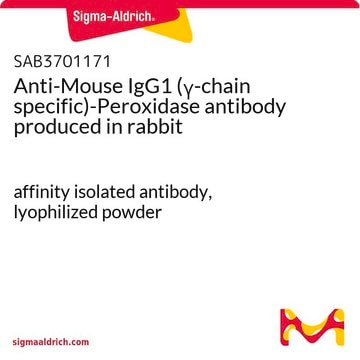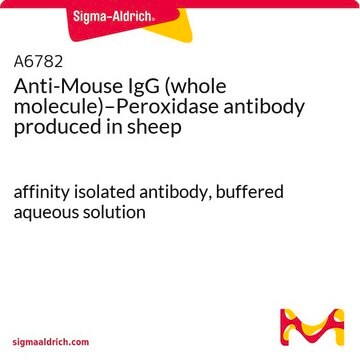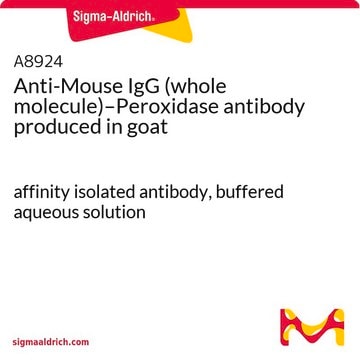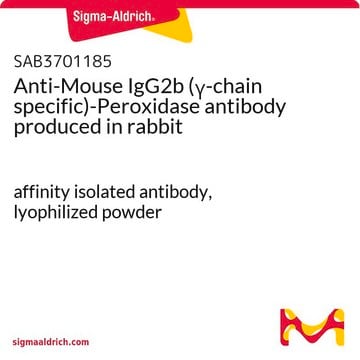Kluczowe dokumenty
A3682
Anti-Mouse IgG (Fab specific)–Peroxidase antibody produced in goat
affinity isolated antibody, buffered aqueous solution
Synonim(y):
Kozie anty-Mysie IgG (specyficzne dla Fab) - HRP
Wybierz wielkość
1560,00 zł
Wybierz wielkość
About This Item
1560,00 zł
Polecane produkty
pochodzenie biologiczne
goat
białko sprzężone
peroxidase conjugate
forma przeciwciała
affinity isolated antibody
rodzaj przeciwciała
secondary antibodies
klon
polyclonal
Formularz
buffered aqueous solution
reaktywność gatunkowa
mouse
spodziewany brak reakcji z
human, rat
metody
direct ELISA: 1:40,000
immunohistochemistry (formalin-fixed, paraffin-embedded sections): 1:150
western blot: 1:80,000-160,000 using detecting β-actin in total cell extract of HeLa cells (5-10 μg per lane)
Warunki transportu
dry ice
temp. przechowywania
−20°C
docelowa modyfikacja potranslacyjna
unmodified
Szukasz podobnych produktów? Odwiedź Przewodnik dotyczący porównywania produktów
Powiązane kategorie
Opis ogólny
Goat anti-mouse IgG (Fab specific)-peroxidase antibody is specific for mouse IgG and the Fab fragment of mouse IgG. The antibody reacts with all mouse IgG subclasses (G1, G2a, G2b and G3) and also with mouse IgA, IgM and IgE. Moreover, the antibody conjugate shows no reactivity with the Fc fragment of mouse IgG or with human and rat IgG.
Immunogen
Zastosowanie
- enzyme-linked immunosorbent assay (ELISA)
- immunohistochemical studies
- dot or immunoblotting
Działania biochem./fizjol.
Postać fizyczna
Uwaga dotycząca przygotowania
Oświadczenie o zrzeczeniu się odpowiedzialności
Nie możesz znaleźć właściwego produktu?
Wypróbuj nasz Narzędzie selektora produktów.
Hasło ostrzegawcze
Warning
Zwroty wskazujące rodzaj zagrożenia
Zwroty wskazujące środki ostrożności
Klasyfikacja zagrożeń
Skin Sens. 1
Kod klasy składowania
12 - Non Combustible Liquids
Klasa zagrożenia wodnego (WGK)
WGK 2
Temperatura zapłonu (°F)
Not applicable
Temperatura zapłonu (°C)
Not applicable
Wybierz jedną z najnowszych wersji:
Certyfikaty analizy (CoA)
Nie widzisz odpowiedniej wersji?
Jeśli potrzebujesz konkretnej wersji, możesz wyszukać konkretny certyfikat według numeru partii lub serii.
Masz już ten produkt?
Dokumenty związane z niedawno zakupionymi produktami zostały zamieszczone w Bibliotece dokumentów.
Klienci oglądali również te produkty
Active Filters
Nasz zespół naukowców ma doświadczenie we wszystkich obszarach badań, w tym w naukach przyrodniczych, materiałoznawstwie, syntezie chemicznej, chromatografii, analityce i wielu innych dziedzinach.
Skontaktuj się z zespołem ds. pomocy technicznej


















